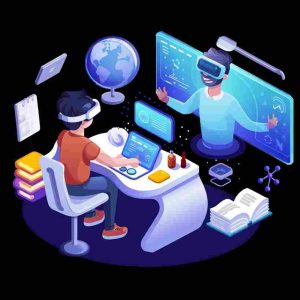In recent years, online education has surged to the forefront of the educational landscape, reshaping the way we acquire knowledge and skills. With the proliferation of digital technologies and the internet, the traditional classroom is no longer the sole domain of learning. Instead, virtual classrooms, interactive platforms, and multimedia resources have become integral components of the educational journey. In this blog post, we delve into the transformative power of online education and explore its myriad benefits, challenges, and future prospects.

The Rise of Online Education: A Paradigm Shift
Gone are the days when education was confined to the physical confines of brick-and-mortar institutions. Online education has democratized learning, making it accessible to individuals across geographical boundaries and socioeconomic backgrounds. Whether you’re a working professional seeking to enhance your skills, a stay-at-home parent pursuing higher education, or a student craving flexibility in your learning schedule, online education offers a flexible and convenient alternative to traditional classroom-based instruction.
Benefits of Online Education
Online education offers numerous benefits:
1. Customized Learning Experience: Online education allows learners to tailor their learning experience to their individual preferences and needs. They can choose courses that align with their interests, career goals, and learning styles. Furthermore, they have the flexibility to focus on specific topics or skills, bypassing material they may already be familiar with or not interested in.
2. Global Networking Opportunities: Through online education platforms, learners have the chance to connect with peers, instructors, and professionals from around the world. This global networking opens doors to diverse perspectives, collaborations, and potential career opportunities. It enables learners to build a broad professional network that transcends geographical boundaries.
3. Improved Time Management Skills: Engaging in online education requires discipline and effective time management. Learners must allocate time for studying, completing assignments, and participating in discussions while balancing other commitments. As a result, they develop valuable time management skills that are applicable in both academic and professional settings.
4. Enhanced Technological Proficiency: Participating in online education inherently involves using various digital tools and platforms. As learners navigate through online courses, they become more proficient in using technology, including learning management systems, video conferencing software, and online collaboration tools. These technological skills are increasingly valuable in today’s digital-centric world.
5. Self-Directed Learning: Online education empowers learners to take ownership of their learning journey. They have the autonomy to set goals, manage their progress, and seek out additional resources as needed. This fosters a culture of self-directed learning, encouraging individuals to become lifelong learners who actively pursue knowledge beyond the confines of formal education.
6. Accessibility for Diverse Learners: Online education can cater to the needs of diverse learners, including those with disabilities or special learning requirements. Accessibility features such as closed captioning, screen readers, and alternative formats for course materials ensure that educational content is accessible to all individuals, regardless of their abilities or limitations.
7. Eco-Friendly Learning Environment: Online education contributes to environmental sustainability by reducing the need for physical infrastructure and minimizing carbon emissions associated with commuting. By eliminating the necessity for travel to traditional classrooms, online education helps reduce the carbon footprint and promotes eco-friendly practices.
8. Real-time Feedback and Assessment: Online education platforms often provide immediate feedback on assessments and assignments, allowing learners to gauge their progress and understanding in real-time. This prompt feedback loop enables learners to identify areas for improvement and adjust their study strategies accordingly, leading to more effective learning outcomes.
Challenges and Opportunities: Navigating the Digital Divide
1. Socioeconomic Disparities: The digital divide often exacerbates existing socioeconomic inequalities, with disadvantaged communities facing limited access to technology and the internet. Low-income households may struggle to afford devices or reliable internet connections, hindering their participation in online education. Bridging the digital divide requires addressing these socioeconomic disparities through targeted initiatives aimed at providing equitable access to technology and digital resources.
2. Rural and Remote Accessibility: Residents of rural and remote areas often encounter challenges in accessing high-speed internet and technological infrastructure. Limited broadband coverage and geographical isolation can impede their ability to engage effectively in online education. To overcome this barrier, initiatives such as government subsidies for broadband expansion and community-based internet access projects are essential for ensuring equitable access to online learning opportunities.
3. Digital Literacy and Skills Gap: Access to technology alone is insufficient without adequate digital literacy skills. Many individuals, particularly older adults, and marginalized groups may lack the necessary knowledge and proficiency to navigate online platforms, use digital tools effectively, and discern reliable information from misinformation. Bridging the digital literacy gap requires comprehensive education and training programs that empower individuals with the skills needed to thrive in the digital age.
4. Quality Assurance and Credibility: As the popularity of online education grows, ensuring the quality and credibility of online courses becomes paramount. Concerns may arise regarding the rigor of instruction, accreditation status, and authenticity of credentials offered by online institutions. Accreditation bodies, regulatory agencies, and industry stakeholders play a crucial role in establishing standards and guidelines to uphold the integrity of online education and maintain public trust in digital credentials.
5. Student Engagement and Retention: Engaging and retaining students in virtual learning environments presents unique challenges compared to traditional classrooms. Factors such as technological distractions, lack of face-to-face interaction, and feelings of isolation can impact student motivation and persistence. Effective strategies for enhancing student engagement include interactive multimedia content, collaborative learning activities, and personalized support mechanisms tailored to individual learner needs.
6. Infrastructure Investment and Policy Advocacy: Addressing the digital divide requires sustained investment in broadband infrastructure, particularly in underserved communities. Government agencies, private sector stakeholders, and nonprofit organizations must collaborate to allocate resources effectively, prioritize digital inclusion initiatives, and advocate for policies that promote universal access to affordable and reliable internet services. Additionally, funding opportunities for educational institutions and community organizations can facilitate the procurement of devices and technology training programs for underserved populations.
7. Community Partnerships and Collaborations: Community-based approaches are essential for bridging the digital divide and promoting digital inclusion. Partnerships between educational institutions, local governments, nonprofit organizations, and industry partners can leverage collective resources and expertise to support initiatives such as digital literacy workshops, technology access programs, and community Wi-Fi hotspots. By fostering collaboration and engagement at the grassroots level, communities can empower individuals to overcome barriers to online education and unlock opportunities for lifelong learning.
Embracing the Future: Innovations in Online Learning
As technology continues to evolve, so too does the landscape of online education. From artificial intelligence and virtual reality to gamification and adaptive learning algorithms, emerging technologies are revolutionizing the way we teach and learn. These innovations hold the potential to personalize learning experiences, tailor instruction to individual needs, and create immersive environments that stimulate curiosity and creativity. By embracing these advancements, online education can continue to evolve and adapt to the changing needs of learners in the digital age.
Conclusion: Charting a Course for Lifelong Learning
In conclusion, online education represents a paradigm shift in the way we approach learning and skill development. It transcends the constraints of time and space, offering a flexible and accessible avenue for individuals to pursue their educational aspirations. However, realizing the full potential of online education requires addressing challenges such as the digital divide and ensuring the quality and credibility of online courses. By harnessing the power of technology and embracing innovative pedagogical approaches, we can chart a course for lifelong learning and empower individuals to thrive in the knowledge economy of the 21st century.



